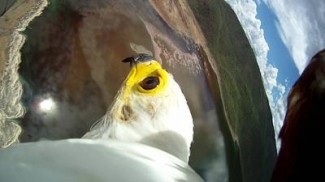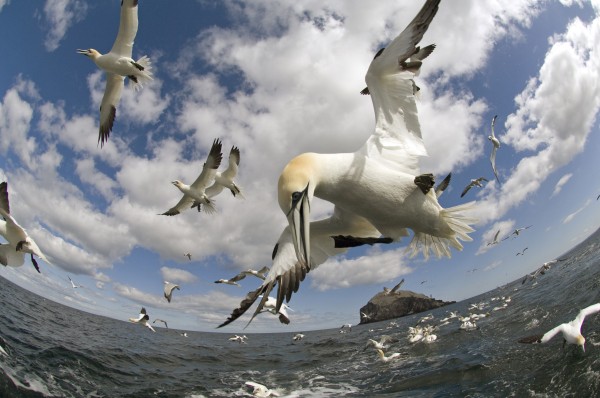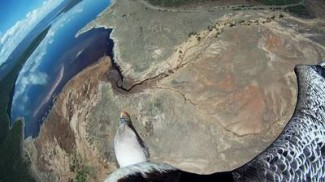INTERVIEW: ‘Winged Planet’ set to take flight on Discovery Channel

Discovery Channel is set to premiere Winged Planet on Saturday, Oct. 6 at 8 p.m. The expansive project took director/producer John Downer four years to complete, and the TV results include some of the most unique perspectives of the avian world ever caught on camera. Downer’s team set out not to just to film these bird species, but actually to capture them in mid-flight, learning about their migration patterns and eating habits.
Recently, Hollywood Soapbox interviewed Downer about the project. Questions and answers have been slightly edited.
Are you excited to finally have this project air on television?
Oh, yeah. It’s great. Because you’re creating it for an audience, and there’s nothing better when you have the chance to show it.
Could you talk about how long you’ve been with the project?
The project was four years in the making, and it’s something I’ve wanted to do really since I’ve been getting into natural history or wildlife filmmaking. I mean in my early days I made a film that investigated bird flight. It was only half an hour in length. But it did a lot of what we did in Winged Planet, but obviously without the technology which has allowed us to take things so much further.
We were flying with birds … even putting cameras on the back of the bird. We put a camera on a back of a bird for the first time ever. So that was using really old-fashioned super 8 cameras, amateur film cameras. What Winged Planet has allowed us to do is to take some of those techniques but bring them up to a whole new level — high definition and beautiful quality. And also tell a much bigger story, one which covers the world and shows how birds feel and experience the world we share, which is obviously very different (from) what we experience. … That’s what I set out to achieve while making it.

Did you stick to the schedule, or did it take longer than you thought?
Even though technology had advanced, it was still advancing through the project. And there were certain things which, at the beginning of the project, I knew it was better that we waited. Things like developing the bird cameras … it took that long before we really got the camera that we wanted, that could do the job that we wanted, which was to film in slow motion, lighten the carry, the beautiful high definition quality. And that was two years into the project, so we held back on that development.
Other things started to come in toward the end of the project, with things like drones, which could carry cameras really quietly. … Having that length of time allowed us to attempt to capture some extraordinary behavior … things like the boons chasing and catching flamingoes, which is really, really difficult to film. It took us 100 days just to get that sequence. … We’re letting the birds guide us through the story. We have the overall arc of what we were trying to say, but very often the twists and turns that only the birds could give you.
From the audience perspective, how did you get the camera on the bird?
That was the thing, it had to be light enough. Birds always have quite a redundancy in terms of what their payload is. So doing migration, they have to put on huge amounts of weight just to make the journey. Add just a few ounces, the camera was not really significant in terms of the weight that they have to carry. And they were birds that were specially trained and used to doing that. It was a process of actually getting them very used to the camera before they were even involved in the filming. And that was creating harnesses that were specially designed to be really comfortable on the bird and streamlining the camera so they’re not creating drag — all those kind of things. So when the birds were carrying it, they weren’t really aware of the camera at all.

Did you lose any cameras up there?
We did lose the occasional bird for a while, but the whole point is if you’re working with these birds, they are free. They are free to go wherever they want. And it relies on a bond between you and them that they come back to you. They were always designed so the bird could take them off if it became uncomfortable and they were lost somewhere. But we never actually lost a bird for very long. They always came back. … We didn’t lose a single bird over the whole of production, which was very satisfying because they all came back.
Was Discovery Channel involved from the very beginning?
They were involved at the beginning. It’s a BBC and Discovery program, so they shared the financing of it.
When did the work officially end?
The series went out as a series in the U.K. at the beginning of the year. … So we finished the U.K. version around Christmas last year.
What was the biggest surprise from the footage?
I think what was the biggest surprise, and we learned this quite early on … I think when we set off we weren’t so aware of how birds work with other animals. I mean one typical thing of that is … South Africa, where these gannets work with dolphins and also whales to find these incredible concentrations of fish. It’s one of the greatest spectacles on earth. … It’s always been filmed from the perspective of dolphins and sharks. Once we took the bird’s view, we realized they were basically the eyes in the sky for all these other animals. So they were interacting and working together, and so many of the stories you discover that everyone’s watching everyone. Vultures are watching the lions. The lions also watch the vultures, because they both lead them to food. So you’re getting these incredible relationships that people largely haven’t thought about it.
When you look back at Winged Planet … are you happy with the results? Did you achieve your goals?
In some ways we achieved more than the goals. Because you’re kind of at the beginning, you set your ambitions high, but sometimes you just don’t know what’s achievable. But by the end of it, you do get new goals. You see what else you could have done. And I think that’s always the thing about filmmaking, you should never be totally satisfied with what you made, because you could always make something better. And that drives you on to make the next one.
A lot of experience and what we’ve learned along the way will feed into the next production, and we will aim to create something better or certainly different and exploring new subjects. You just build up more and more experience, particularly with this viewpoint, which Winged Planet has got, which is taking an animal’s view of the world. That can be applied to so many things.
By John Soltes / Publisher / John@HollywoodSoapbox.com
-
Winged Planet premieres Saturday, Oct. 6 at 8 p.m. on Discovery Channel.

